#Taoist rituals
Text
Martial arts as ritual violence
The interrelationship between Chinese popular religion and martial arts is both obvious and complex.
#chinesemartialarts #masculinity #martialarts #chinesehistory #chineseculture #brotherhood #riversandlakes #swornbrotherhood #jianghu #yiqi #tiandihui
Excerpt from: Gods, Ghosts, and Gangsters: Ritual Violence, Martial Arts, and Masculinity on the Margins of Chinese Society
by Avron Boretz
(more…)

View On WordPress
#ancient China#brotherhood#Chinese history#Chinese martial arts#Jianghu#martial arts traditions#martial gods#masculinity#ritual oaths#Rivers and Lakes#Taoist rituals#Wuxia
2 notes
·
View notes
Photo



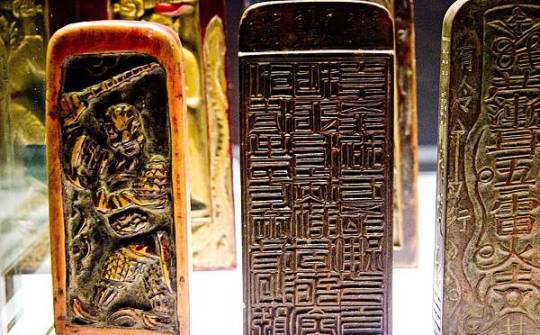
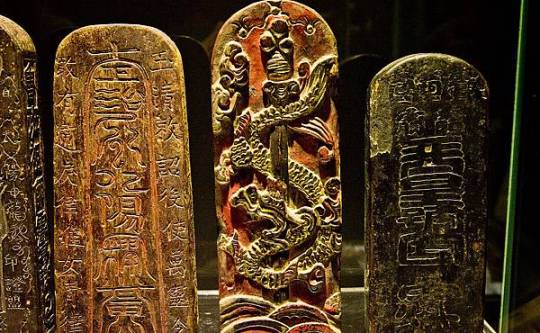
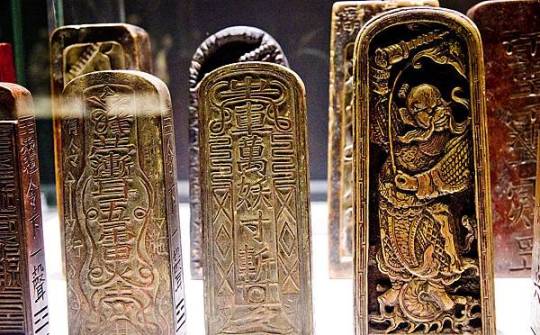

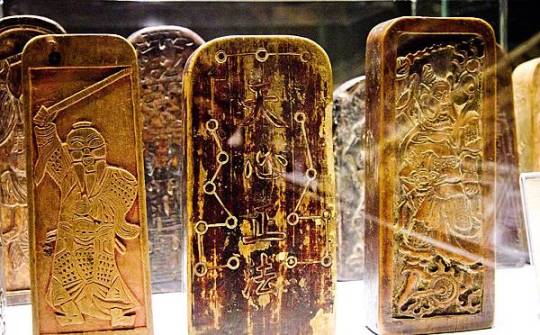
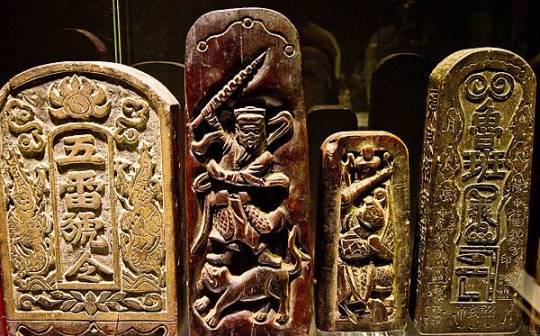
Ming and Qing Taoist tokens (Ling Pai 令牌 aka Lei Ling 雷令or Wu Lei Hao Ling 五雷號令) used in the Thunder Rites (Lei Fa 雷法). Mostly from Lushan Taoist school (閭山派), Fujian.
The tokens are made of wood, often peach wood or jujube, however, jade, ivory, bamboo root, etc. are allowed. The rounded top represents Heavens and the rectangular base – Earth.
The Ling Pai are engraved with signs corresponding to those divinities or forces with which the practitioner interacts during the Rites. The patterns and shapes may vary depending on the Taoist school and lineage, but the overall structure remains recognizable.
Photo: © Lin Mengyi, Xuanwu Daomen Taoist Research Center (林孟毅 玄武道門 道教研究中心), Taiwan.
#qing dynasty#qing#ming dynasty#ming#taoism#taoist#taoist immortal#yuan dynasty#taoist sorcery#taoist magic#chinese mythology#daoism#daoist#chinese myth#chinese culture#ancient china#taoist spell#fu talisman#taoist talisman#taoist ritual#leifa#taoist seals#thunder rites#雷法#xuanwu#真武#zhenwu#玄武#玄天上帝#xuantian shangdi
224 notes
·
View notes
Text
[Hanfu · 漢服]Chinese immortal Hanfu <西王母/Queen Mother of the West> Based On Yuan Dynasty Taoist Temple Mural<永乐宫/Yongle Palace>
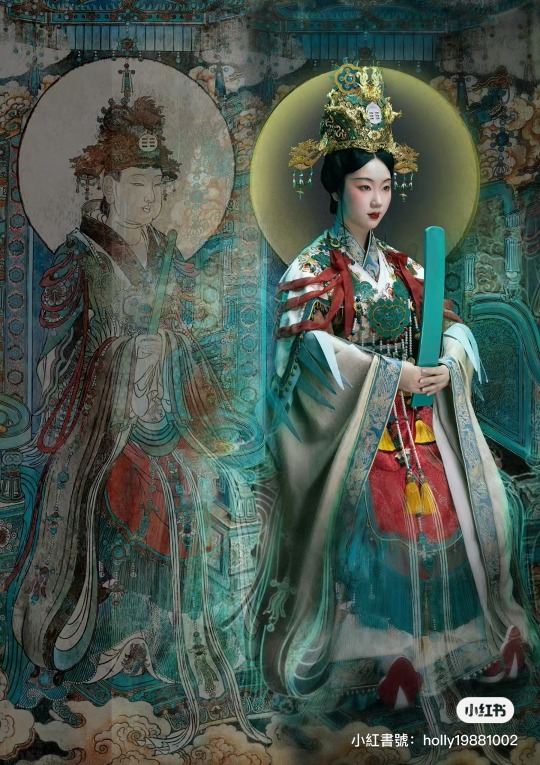
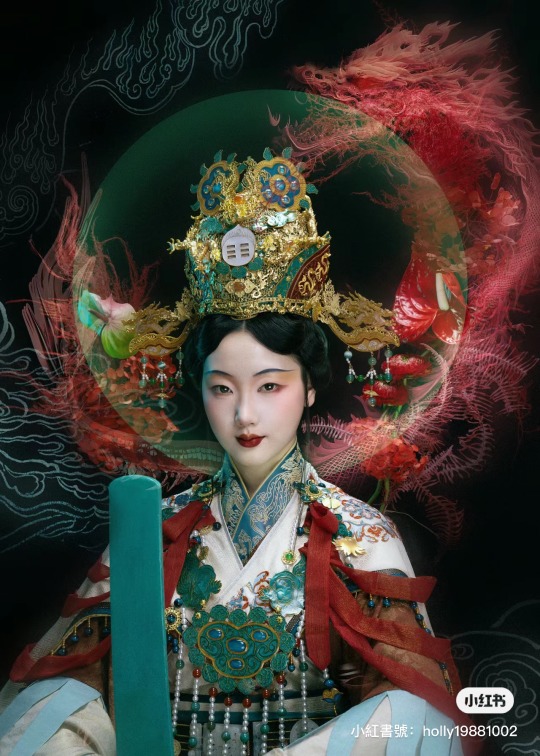
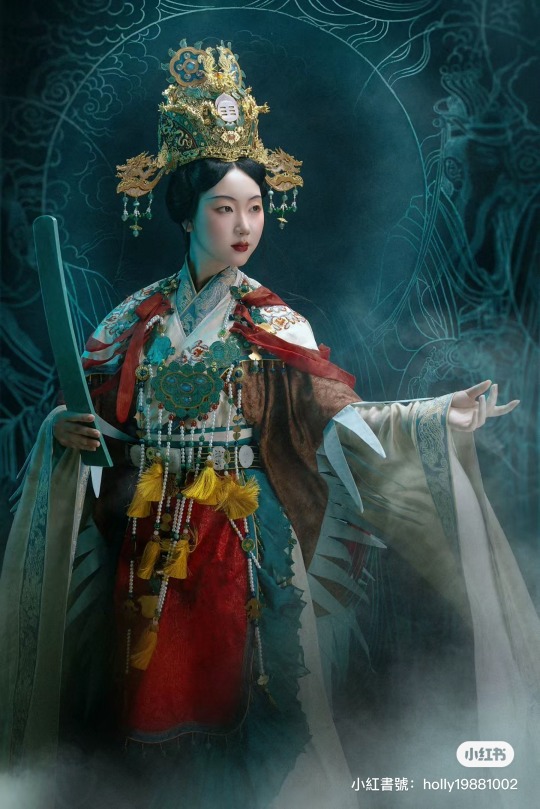
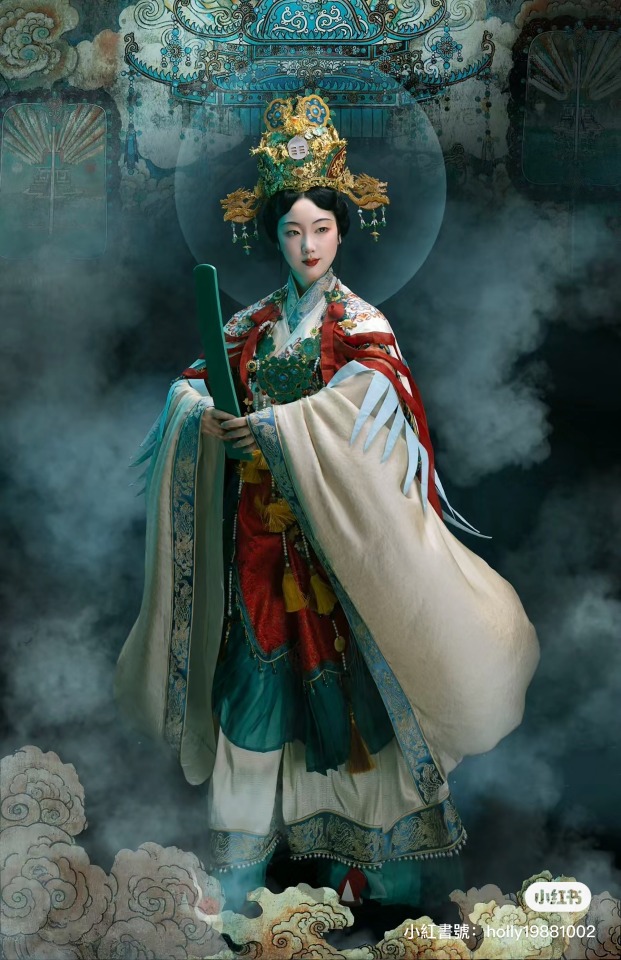
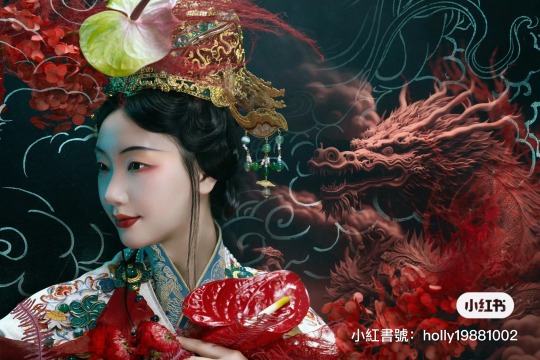
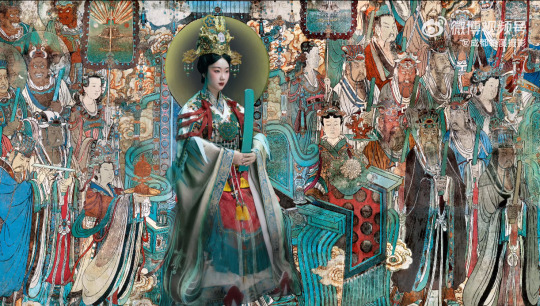
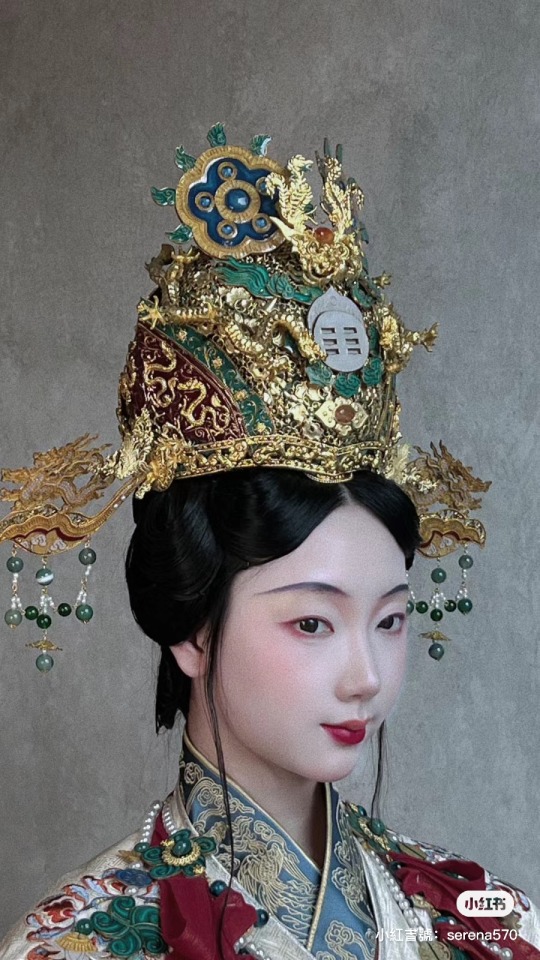
【Historical Artifacts Reference 】:
▶ China Yuan Dynasty Taoist Temple 永乐宫/Yongle Palace Mural


<西王母/Queen Mother of the West>
The Queen Mother of the West, known by various local names, is a mother goddess in Chinese religion and mythology, also worshipped in neighbouring Asian countries, and attested from ancient times.
The first mentions of the Queen Mother date back to the oracle bone inscriptions of the Shang dynasty (1766 – 1122 BCE).
One inscription reads:
Crack-making on day IX (9th day), we divined. If we make offering to the eastern mother and the western mother, there will be approval.
Western Mother refers to an archaic divinity residing in the west. The exact nature of the Mother divinities in the Shang dynasty is unclear, but they were seen as powerful forces deserving of ritual by the people of the Shang dynasty.
Originally, from the earliest known depictions of her in accounts like the Classic of Mountains and Seas during the Zhou dynasty, she was a ferocious goddess of death with the teeth of a tiger, who rules over wild beasts and sends down heavenly punishments such as pestilences. She was also mentioned as an authority ruling over other divinities such as Jiutian Xuannü, a goddess of war and sex.
Other stories hold that she is a mountain goddess or a divine tigress. She is also popularly thought to have blessed the Eight Immortals with their supernatural abilities.
After her integration into the Taoist pantheon, she gradually took on associations with other aspects, such as immortality, as well.
The Queen Mother of the West is most often depicted holding court within her palace on the mythological Mount Kunlun, usually supposed to be in western China (a modern Mount Kunlun is named after this). Her palace is believed to be a perfect and complete paradise, where it was used as a meeting place for the deities and a cosmic pillar where communications between deities and humans were possible.At her palace she was surrounded by a female retinue of prominent goddesses and spiritual attendants. One of her symbols is the Big Dipper.
Although not definite there are many beliefs that her garden had a special orchard of longevity peaches which would ripen once every three thousand years,others believe though that her court on Mount Kunlun was nearby to the orchard of the Peaches of Immortality. No matter where the peaches were located, the Queen Mother of the West is widely known for serving peaches to her guests, which would then make them immortal. She normally wears a distinctive headdress with the Peaches of Immortality suspended from it.
Flourishing parasols, we reach the chronograms' extremity;
Riding on the mist, I wander to Lofty Whirlwind Peak.
The Lady of the Supreme Primordial descends through jade interior doors;
The Queen Mother opens her Blue-gem Palace.
Celestial people—What a Crowd!
A lofty meeting inside the Cyan Audience Hall.
Arrayed Attendants perform Cloud Songs;
Realized intonations fill the Grand Empty Space.
Every thousand years, her purple crabapple ripens;
Every four kalpas, her numinous melon produces abundantly.
This music differs from that at the feast in the wilderness—
So convivial, and certainly infinite.— Wu Yun (Complete Tang Poems 1967, line 4942)
One of the earliest written references to the Queen Mother comes from the writings of the Taoist writer Zhuangzi (c. 4th century BCE):
The Queen Mother of the West obtained it [the Dao]... ...and took up her seat at Shao kuang. No one knows her beginning; no one knows her end.
Zhuangzi describes the Queen Mother as one of the highest of the deities, meaning she had gained immortality and celestial powers. Zhuangzi also states that Xiwangmu is seated upon a spiritual western mountain range, suggesting she is connected to not only the heavens, but also to the west.
Legendary encounters
In Tu Kuang-ting's text, he includes narrative accounts of the Queen Mother's encounters with legendary Chinese heroes. One such account narrates an encounter between the Queen Mother and Laozi (Lord Lao):
"In the 25th year of King Chao of the Chou dynasty (1028 BCE) …"
"…Lord Lao and the realized person Yin Hsi went traveling…"
"…on their behalf, the Queen Mother of the West explicated the Scripture of Constant Purity and Quiet."
In this account, the Queen Mother plays the role of Laozi's superior and is credited with the ultimate authorship of the Dao De Jing. This dichotomy of the Queen Mother as the superior is a characteristic of Shangqing Taoism, a goddess worshiping sect of Taoism of which Tu Kuang-ting was a master. There is also an account of a meeting between the Queen Mother and Laozi in Tang poetry.[18] This account however, being of traditional Taoist thought, has the Queen Mother taking an inferior role to Laozi, calling him "Primordial Lord" (the title of his highest manifestation) and pays homage to the sage.

<China Han Dynasty stone-relief showing 西王母/Queen Mother of the West from Sichuan,China>

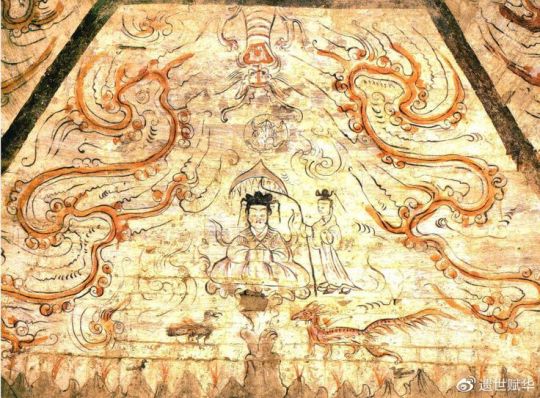
<China Wei and Jin Dynasties Mural showing 西王母/Queen Mother of the West>
————————
📸Photography post-production :@小何力
👗Hanfu & 👑Crown:@雁鸿Aimee
💄 Makeup:百丽 (临溪摄影)
👭Model:@清音音音音
🔗 Weibo:https://weibo.com/1648616372/O2R5bpBud
————————
#chinese hanfu#immortal hanfu#西王母/Queen Mother of the West#Chinese mythology#hanfu#hanfu accessories#hanfu_challenge#chinese traditional clothing#china#chinese#chinese history#china history#漢服#汉服#中華風#小何力#雁鸿Aimee#永乐宫/Yongle Palace
231 notes
·
View notes
Text
The ritual aspects of religion are far more fascinating and worth preserving than the theology, that thing Japan has going on where they have a bunch of incoherent festivals that none of the participants understand the meaning or purpose of seems like it's the way to do it. Nobody to the left of Shinzo Abe even remembers which stuff was Buddhist or Shinto or Taoist anymore.
So I really think the problem in the west is not appropriating religion enough. If you're truly upset about "cultural Christianity" and not just concern trolling messianic Zionism, the best response is to celebrate christian rituals as loudly, offensively, and incorrectly as possible. Get a giant inflatable light-up hippopotamus dressed as santa claus and stick it in your front yard the day after Thanksgiving. Invite your devout christian coworkers out for chinese food on Christmas morning and act disappointed when they can't come along. Buy a Christmas tree and put a menorah on top of it instead of a star. Ask white people if they celebrate Kwanzaa.
158 notes
·
View notes
Text

冷面蛇鞭 - 沈郎魂
Shên LángHún, cold-faced assassin
My heart just goes BOOM every time I see YáoYao in make up and costume for ShûiLóngYín 水龍吟 (Water Dragon Chant).
Also I'm wheezing because 蛇鞭 is a type of whip (or a taoist ritual item) but 鞭 also means animal penises (served as food, which includes snakes'). 🍆🤣
...☕?/commission
#shui long yin#shen langhun#水龙吟#cdrama#fanart#xiao shunyao#yaoyao looks so good and I'm so excited he's working with luo yunxi again#some days wanting to see faves in upcoming interesting projects is the only reason to carry on but that's already a small victory#lyselkatzcreations#cnovelartreblogs
35 notes
·
View notes
Text
Wait a minute, I’m having a moment here. When I first read this novel, Xie Lian’s infamous “body in the abyss, heart in paradise” phrase always confused me. I personally didn’t get it nor the significance of it to the characters and simply thought that maybe I was missing some cultural context to it that would’ve made it make sense. I still feel that to some extent but also, the context around why he said that just clicked to me. When he goes to Yi Nian Bridge to defeat the ghost that haunts it, this is their only exchange:
The ghost appeared in a flash, and sure enough, it was as eerie and terrifying as what the rumours had claimed. It opened its mouth to ask the Crown Prince the first question, which the Crown Prince replied to him with a smile, “This is the human realm.”
However, the ghost replied, “This is the abyss.”
—Chapt. 1: Heaven Official’s Blessing
Xie lian says that they are in the human realm, but the ghost replies that this is “the abyss.” The ghost has obviously been tormented, unable to rest and unable to move on. To him, everywhere is “the abyss.” But then, Xie Lian defeats him. And not only does Xie Lian defeat him, he does this:
After the ghost disappeared, the Crown Prince planted a flowering tree at the foot of the bridge. At that moment, a Taoist passing through saw him scatter a handful of golden soil to help escort the ghost to its next life. He asked, “What are you doing?”
The Crown Prince then spoke his famous eight words: “Body in the abyss, but heart in paradise.”
I think there’s a literal and metaphorical meaning to this phrase. For the ghost, his body is still and forever trapped on earth (so Xie Lian believes with the knowledge he had at the time), but by still performing calming rituals to help the ghost move on, the ghost’s heart can still find itself in paradise. Likewise, Xie Lian spends most of his life (and the book) stuck on earth, struggling through hardship and torture and betrayal and abandonment, and through his care for mortals and commoners, he may never find himself fully able to leave “the abyss” (and does he even want to?). But by staying true to his morals and dedicating himself to planting little seeds of hope wherever he goes, he can still feel his heart in paradise, free of regrets that would have plagued him had he taken the easy route by sacrificing his heart to the abyss while using others as stepping stones to drag his body out.
#human reads tgcf: take 1.5#human metas mxtx#this may be old news#but as we know i do not fuck with the tgcf fandom like that#so i'm also in the abyss with some of these thoughts lmao
107 notes
·
View notes
Text
Time for some thoughts and feelings.
I think it's very much a western cultural Christian influence that leads to many new Pagans/polytheists being hesitant of or nervous about incorporating multiple and different pantheons into one diverse religious practice.
You may not be consciously aware of this, but when you've known about "the one true god" who shall have no other gods before him your whole life, it's going to come back to you. Even if you've always rejected everything that has to do with all that. We are, after all, products of our environments.
I'm from a polytheistic culture. My native land has more than a couple of "main" religions. We incorporate practices, traditions, and rituals from our people's wide array of spiritualities side by side, mix and match. We'd go to a Buddhist temple to pray, throw a Taoist Chinese new year celebration, have a birthday party involving deities from Chinese folk religion, and those of us from the minority ethnic groups would here and there throw in our own things. And it's just never even been on our radar that there would ever be any problem or "conflict" about it all.
So if you're interested in developing a polytheistic religious practice, you might need to train your brain to think from a polytheistic point of view, and not from the dominant Christian culture that you may have been fully immersed in without realizing up to this point.
#religious advice#religions#paganblr#paganism#polytheism#deities#deity work#witches of color#spirituality#cultural christianity
125 notes
·
View notes
Text
Beginner Class - Introduction to Meditation
Ancient Craft & Occultism
Introduction to Meditation
___
By KB
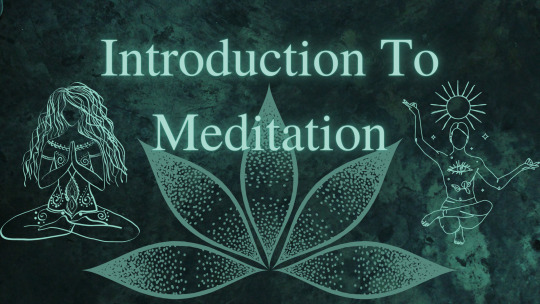
Introduction
Hello again, everyone! Welcome back to the next lesson for the Beginner Class. Last lesson, we talked about finding your personal center as well as a bit more in depth on grounding. Well, today, we'll be taking a closer look at the many forms and practices of meditation.
What Is Meditation?
Meditation is an essential aspect of witchcraft and magic practice as it allows you to interact with the universe (or your higher power) through conscious thought and focused desire. Ritual, spellwork, and your regular thoughts and speech are examples of other techniques. Meditation is a discipline in which one trains the mind and creates a state of consciousness in order to gain some advantage. Meditation encompasses a wide range of different activities and practices. We will go into more detail in the following sections.
Nearly every culture in the world has some connection to meditation. Whatever the design, they are typically intended to encourage connecting with spiritual guidance, feeling at ease, developing inner strength, having psychic visions, becoming closer to God, remembering former lives, going on astral journeys, and more. Meditation is a well-known, age-old technique that has been used for millennia to promote calmness, concentration, and connection with our inner selves. The benefits of meditation on the mind, body, and soul are reciprocal.
A Brief History
In actuality, nobody is certain of the exact beginning and location of meditation. But our theories are supported by facts. This ancient rite is mentioned in many civilizations and religions, including Hinduism, Buddhism, Judaism, Islam, and Christianity. All of these faiths have something to offer to the modern understanding of meditation as it is practiced today. Although the history of meditation is controversial, many people think it began there more than 5000 years ago.
India Origins
It is generally accepted that the Vedas, a collection of Hindu writings, include the oldest written account of meditation. The Vedic books were written around 1500 BCE. The Vedas include mention of a practice known as "Dhyana," which is considered to be the first example of meditation that we are aware of. In Sanskrit, the word "dhyana" implies "contemplation" or "meditation." It is intended to calm the mind and attain "thoughtless awareness." However, Vedantism is frequently rejected by Buddhist beliefs in favor of the Buddha's teachings.
The various Buddhist levels of meditation can also be found in other ancient Indian scriptures dating back to the first century BCE. These texts are known as the Pli Canon Sutras. The Pli Canon is a body of Theravada Buddhist literature. And then there's Buddha. Siddhartha Gautama, an Indian prince, was the inspiration for Buddha. He was looking for a means to end human pain. Gautama attempted numerous strategies, but none of them seemed to work. He sat down under a tree one day and determined not to move until he discovered the solution he sought. He attained enlightenment after 49 days of meditating and started the Buddhist faith. The practice of meditation is claimed to have spread throughout India from there. Buddhist monks embraced meditation as a means of achieving inner peace, frequently sitting for hours in silence, meditating on their master's teachings.
Asia Origins
Around the sixth century BCE, the practice of meditation spread to China, where it was influenced by Taoism and Buddhism. At the end of the Han dynasty, Buddhist monks from India introduced meditation to China. Over the next century, the practice began to blend into Chinese culture. The Taoists also believed in the efficacy of meditation and devised their own techniques for mind-stilling. One famous Taoist meditation practice is known as "Qigong." Qigong is a type of moving meditation that entails slow, gentle motions as well as deep breathing. Meditation extended from China to Japan, Korea, and other parts of Asia. Zen Buddhists perform "Zazen," a type of meditation practiced in Japan.
The technique was introduced to Japan by the Japanese monk Dosho, who journeyed to China to study Buddhism under the famous master Hsuan Tsang. Zazen, which translates as "seated meditation," is sitting in quiet with one's eyes closed. Korea has its own type of meditation known as "Won," which is based on Buddhist and Taoist concepts. It is a sort of moving meditation in which gentle, rhythmic motions are used to calm the body and mind.
Western Origins
Meditation became popular in the Western world in the twentieth century. Maharishi Mahesh Yogi was among the first Westerners to popularize meditation. Maharishi is most known for popularizing the technique of "transcendental meditation" in the 1960s. The Yogis are a Hindu group that believes in the power of meditation to help one achieve enlightenment. The term "yoga" truly means "union" or "connection." Yoga seeks to unite the mind, body, and soul.
Other Yogis, such as Paramahansa Yogananda, who penned the classic book "Autobiography of a Yogi," also contributed to the introduction of meditation to the West. Maharishi's method of meditation is closing our eyes and reciting a mantra. A mantra is a word or phrase that is repeated repeatedly. The idea is to concentrate on the chant while clearing our brains.
Meditation & Spirituality
Spirituality is a broad topic with numerous interpretations. In general, it encourages a sense of connection to something larger than ourselves, as well as a connection with your higher self or higher awareness. It promotes the search for meaning in life and living with a broader perspective. It has a highly global appeal--something that all humans can relate to. A spiritual experience may be described as sacred, ethereal, mystical, or transcendent, or simply as a deep sense of positive emotions such as calm, amazement, wonder, connectivity, contentment, appreciation, acceptance, compassion, and unconditional love. All of these are true characteristics of our spirit.
Spiritual meditation, as the term implies, is that which connects you to your spirit. It pushes you past your limiting identities and labels to the core of who you truly are. You as your authentic self - joy, love, and tranquility. You may feel a rain of grace and happiness, as well as a deep sense of closeness and oneness, if you practice spiritual meditation. The desire to practice spiritual meditation stems from an underlying desire to perceive and think beyond the apparent world. Spiritual meditation can assist you in discovering the everlasting truth and meaning of existence. It keeps you anchored in the present moment, where you want to be and find peace.
Any genuine meditation practice, when practiced over time, can aid in your spiritual growth and will begin to provide the following spiritual benefits:
A balanced and grounded sense of being
Experience of deep inner stillness and peace
Radiating serenity, calmness, and love
A sense of awakening and freedom
Less emotional reactions
More awareness and mindfulness
Sense of inner bliss regardless of situation
The feeling of always being home
Belonging and connecting to all
Great abundance and security
Increased creativity and free thinking
More resilient to anger and stress
Meditation & General Health
Although meditation has been practiced for many years and is known to have many positive effects on the mind, it is only recently that science has established a strong connection between meditation and physical health. It's simple to feel overpowered by ideas and emotions in the fast-paced world of today. We all know the damage stress and anxiety can do to our health. Stress and anxiety are frequently caused by emotional overload. Nowadays, professionals from all over the world agree that practicing mindfulness for a little period of time each day can make a huge difference. The advantages of meditation for both the body and the mind are well-documented and very compelling. Here's just a few ways frequent meditation can improve our overall health.
daily meditation practice can improve blood circulation, lower the heart rate and help maintain a healthy heart
frequent mindfulness sessions seemed to improve meditators’ immune system functions
produces positive, lasting changes within the brain
meditation not only supports memory and attention, it also enhances mental agility and alertness
women, in general, who practice mindfulness are more aware and accepting of their bodies (also helps with PMS pain)
meditation develops mental awareness and can help you manage triggers for unwanted impulses
meditation can diminish the perception of pain in the brain
blood pressure decreases not only during meditation but also over time in individuals who meditate regularly
Meditation & Witchcraft
As magical practitioners and witches, one of the most important things we can master is the art of meditation. It allows us to still the soul and quiet the mind, which, in turn, allows us to listen to our intuition and focus on our personal energy. Meditation can also be used as a gateway for higher awareness or entering the astral realm.
Now, meditating may not come easy for a lot of you. This is perfectly normal. When I first started practicing, I had a feeling inside that made me feel extremely goofy, and stupid. The more I ignored it, the louder and stronger it grew. I eventually sat with the voice and came to the conclusion that it was my ego, driven by fear and insecurity. The more I sat with the voice, the less I felt stupid about things. I believe this was my initiative into shadow work. Anyways, back to class -
Utilizing meditation within your craft will prove to be absolutely essential the more you do ritual and spell work. Don't give up hope if "conventional" methods don't work for you. We're going to get into several different techniques of achieving the same meditative state.
Types of Meditation
There are so many different types of meditation, if I went into them all, this lesson would turn into an entire chapter. I'm just going to keep it sweet and simple here, but I absolutely encourage you to look into different methods, especially if none of the ones I have listed work for you. Let's get to it.
Active Meditation
Sitting in silence for even 2 minutes may sound like absolute torture for a lot of you. Good news is, that's not the only way to meditate. Have you ever done a yoga class, a workout session, or even taken a nice, fresh shower & felt a sense of bliss? Well, you experienced a meditative state of mind. You can do this by getting out in nature, cleaning the house, performing an art form, anything that involves movement can be a form of active meditation! Woo-hoo for us neurodivergents!
Body Scan
This method allows you to reconnect the mind to the body in a way that notices any physical sensations or tension. While relaxation naturally happens here, the goal is to pay attention to sensory experiences you typically don't notice. This allows you to be more present in your day to day life and is also a wonderful grounding and centering technique.
Mindful Breathing
The body is wiser than the mind, and this technique proves it. It is a very simple, mindless method, but has very profound effects on the body and mind. There are several breathing techniques out there, which I encourage you all to research on your own. All have different effects on the mind and body, so please be sure to choose one that is suitable for you.
Visual Meditation
This is when you focus your mind's eye, or your imagination, into an image to center the mind and the body. The main focus is to imagine and hone in on a memory or something creative and nice that opens the mind's eye. This is a wonderful exercise for those who want to enhance their visualizing abilities.
Sound Meditation
Again, this is exactly as it sounds. This meditation uses sound to provoke a meditative state of mind and align the bodily energies.
#baby witch#elder witch#beginner witch#witchblr#witchcraft#dark witchcraft#astrology#tarot#aesthetic#divination#meditation
61 notes
·
View notes
Text
Could this character be a god?
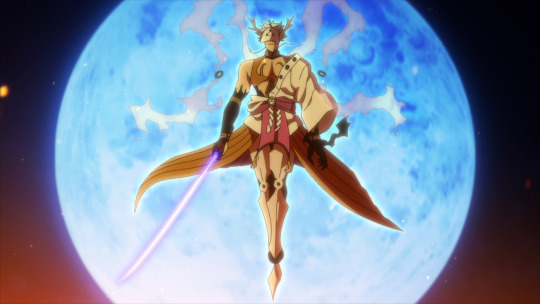
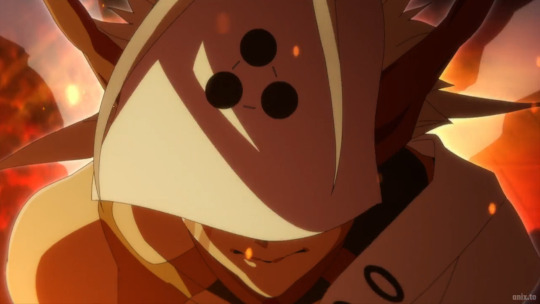
Magical Floating Shawl (hagoromo)
In Japanese media, the raiment is called hagoromo (translated to "feather robe"), or tenne, and is usually worn by supernatural beings, such as youkai, demons, gods, ascended humans, angels, etc. (source)

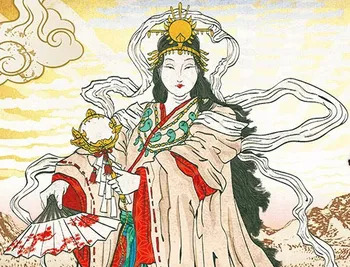
Left: Fūjin, the wind god. Right: Amaterasu, goddess of the sun.
Antlers and Horns in Japanese Folklore
Kirin:
The kirin is one of the rarest, most awesome and powerful creatures ever known in East Asia. It is a regal animal, holy and highly revered. The kirin is often considered a god in its own right. Resembling a deer with scales like a dragon’s covering its body, the kirin is a chimerical beast. (source)
Sacred Deer:
"In Japan, Jurōjin (寿老人) is one of the Seven Gods of Fortune or Shichifukujin, according to Taoist beliefs. He is the god of longevity. ... The deer, a symbol of longevity, usually (but not always) accompanies him as a messenger..." (source)
"Deer are considered messengers to the gods in Shinto, especially Kasuga Shrine in Nara Prefecture where a white deer had arrived from Kashima Shrine as its divine messenger." (source)
Horned Gods and Yokai: various strong gods and yokai in Japanese mythology are depicted with horns.
"Raijin, the god of thunder, is often depicted with a unique appearance. He is shown as having a muscular and fierce build, with horns on his head and sharp claws." (source)
"Fujin, the god of wind ... is represented as a muscular demon with a horned red face and a fierce expression." (source)
"The Oni, a more threatening group of spirits, may have originated in China and traveled to Japan with Buddhism. These horned demons, often of enormous size, can take human or animal shape." (source)
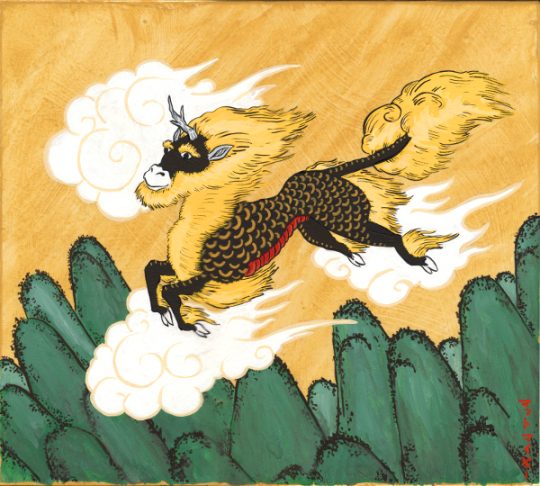

Left: Kirin. Right: Raijin and Fujin fighting.
Masks
"Masks have been used in Japan for centuries, with their usage dating back to at least the 6th century. Traditionally, masks were used in religious ceremonies or rituals, as well as for protection from evil spirits. In more recent times, masks have been used for a variety of purposes, including as part of traditional Japanese theater, in festivals and carnivals, and even as everyday fashion accessories." (source)
In the manga series Natsume Yuujinchou, masks are worn when the protagonist, Natsume, needs to hide the fact he is a human and blend in with the yokai, spirits, and gods he encounters. Many of the masks and disguises he wears incorporate antlers and horns as well.

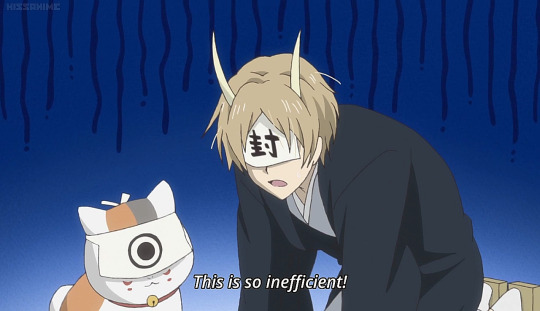
Shide
"Shide (紙垂, 四手) are zigzag-shaped paper streamers, often seen attached to shimenawa or tamagushi to demarcate holy spaces, and used in Shinto rituals in Japan. They are usually found adorning doorways, shrine buildings, and kamidana." (source)


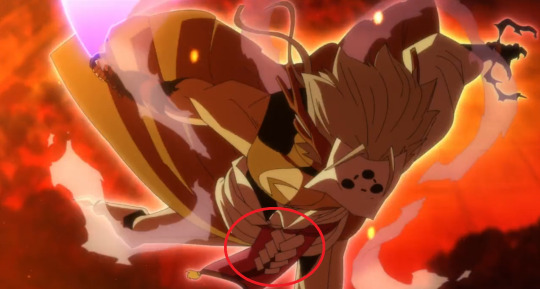
Tori Gates
"A torii is a traditional Japanese gate most commonly found at the entrance of or within a Shinto shrine, where it symbolically marks the transition from the mundane to the sacred and a spot where kami are welcomed and thought to travel through. The presence of a torii at the entrance is usually the simplest way to identify Shinto shrines, and a small torii icon represents them on Japanese road maps." (source)


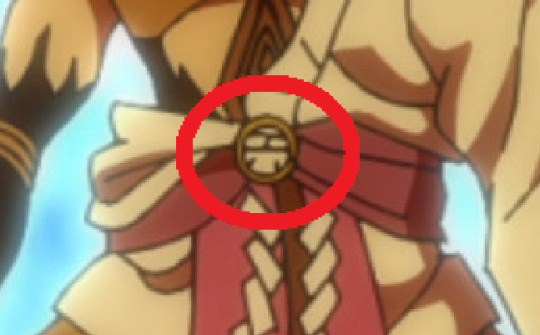
Shinto Symbols
I'm not sure what symbol is on the character's mask, but because there are so many Shinto influences in his design I am assuming the symbol has a similar origin. The closest symbol I was able to find is called a Tomoe.
"The Tomoe is a design that resembles a comma, and is a common design element in Kamon, Japanese family crests, that could be viewed upon the back banners often held by Samurai. This specific Tomoe is called a Mitsudomoe, a three-fold Tomoe, and is perhaps one of the most widely recognisable. Some believe it to be the representation of the threefold division (man, earth and sky) at the heart of Shintoism..." (source)
Below is a chart with variations of the Tomoe symbol:
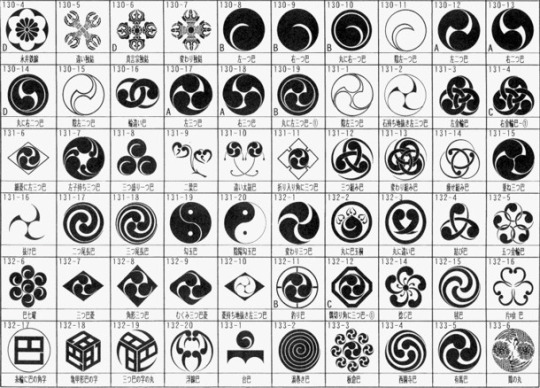
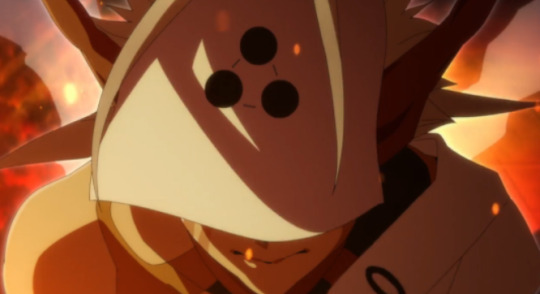
#bungo stray dogs#bungou stray dogs#bsd#season 5#spoilers#fan theory#shinto symbols#I also just figured out that Mishima Yukio was a Shintoist#which only makes me hope that Sigma is the god character who is Mishima Yukio#but it is probably all just me reading into things too much and my wishful thinking
46 notes
·
View notes
Note
sorry words are not very good. is okay to worship Nezha if not born into culture? any resources or link to intro to learning? respect and feel very connected to Nezha mythos and important symbolism, unsure if only ok to devote to deity for eastern tho. thank you for reading ask! sorry if rude or inconsiderate
Please do not worry, I’m actually happy you asked this. I hope Google Translate works well with me today.
The way Nezha is worshipped today is through a Daoist lens, which includes many rules and rituals as well as specific instructions to maintain an altar space. Daoism as a whole, and whichever deity you choose, your ethnicity and culture has no effect on if you can participate. Anyone can.
The very core of Daoism transcends culture and ethnicity, Daoism itself is the Chinese version of something universal. Put differently, wisdom and insight are not things specific to one ethnicity or cultural group, nor can it be “appropriated” with this in mind. It belongs to everyone with an open mind and open heart to learn and understand.
“Under the skies we are all one family.”
I would highly recommend becoming familiar with literature about this, and specifically, “Tao Te Ching” which was written by Lao Tzu. As for links, I did go through and ensure the information within is correct. I hope the articles translate properly for you.
and even this discussion thread was amusing to peruse through.
I hope this has been helpful for you, and anyone else that is curious about Daoism and how Deific Worship works. You are more than welcome to ask more questions if any of this became unclear. Best of luck!
43 notes
·
View notes
Text
Taoist Elements In Sword Forms: A Couple Of Examples
My friend asked to give an example of Taoist element in the form. Well…
For instance, the fragment involving a series of horizontal chou (抽) (or xi, 洗 as variant) with steps to both sides and dian (點) at the end (I’m using the names from Essentials Of the Wudang Sword Art (武當劍法大要)by Huang Yuanxiu, I was taught according to the manual of Li Jinglin).
Continue reading Untitled

View On WordPress
#Chinese history#Chinese martial arts#Chinese sword#Chinese swordsmanship#jian#sword#tai chi#tai chi jian#taiji#Taoism#Taoist magic#Taoist rituals#Wudang sword
1 note
·
View note
Text
Knotting the Banner by David J. Mozina
Academic research unfolding within a living biographical narrative.
This impressive book combines the virtues of ethno-cultural and religious study and adventure novel. In the context of everyday Hunan, the reader discovers a world permeated with cosmogonic meanings: it’s like a Rabbit Hole into Taoist thinking. A complicated mystic quest takes place right in the rural daily routine.
David J. Mozina explores the topic of Banner Rites focused on worship of the Lord Yin Jiao (殷郊 aka 殷交), the principal of the sixty Tai Sui (太歲). The fierce celestial Tai Sui is a much revered guardian deity in Taoist exorcism.
An essential book for the connoisseurs of authentic experiences.
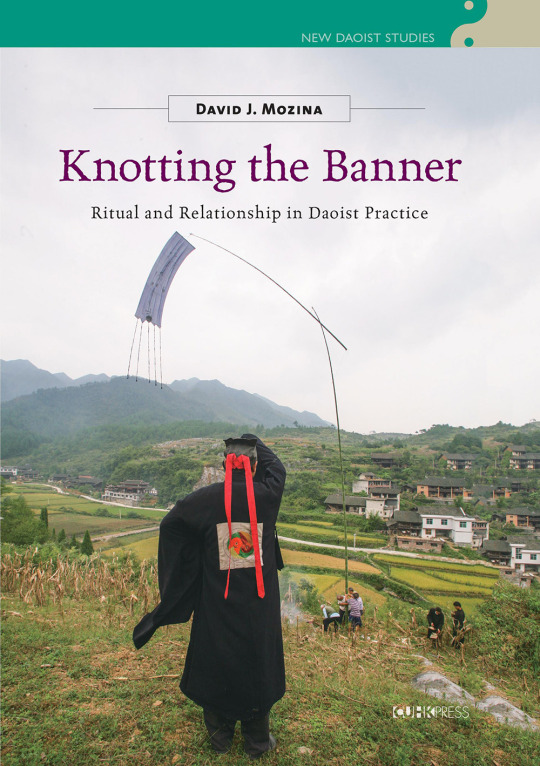
Mozina, D. J. (2021). Knotting the Banner: Ritual and Relationship in Daoist Practice. University of Hawaii Press.
#book boost#book recommendations#book#taoism#taoist sorcery#taoist deities#chinese culture#chinese mythology#taoist magic#taoist#chinese traditions#reading#ancient china#daoism#taoist ritual#taoist immortal#daoist#inner alchemy#neijia#taoist spell#fu talisman#thunder rites#雷法
42 notes
·
View notes
Text
Loose threads and various trivia from the Poppy War series that I can't stop thinking about
I'm writing this because I have very little time to write at the moment so I won't be able to fit all these elements into the Poppy War fic I'm writing but I still have to get it out of the system because the amount of detail is insane.
DrUgS!
Ancient Chinese medicine in general is full of hallucinogenic and poisonous plants that were dosed very carefully, but shamans used them to talk to the gods, and the most common ones were:
The fly agaric mushroom: the mushroom that Chaghan and Qara gave to Kitay and Rin for the anchor ritual.
The ephedra plant: it was generally drunk in the form of tea and I think it's the liquid from the flask Jiang gives Rin in the first book when he sends her to meditate in the forest since Rin describes its effects not as a high but more as the beneficial effects of the plant in question.
The datura plant: it's extremely poisonous and was used in small amounts for its powerful hallucinogenic effects and sometimes its flowers are a blue-violet so I think it's the famous blue powder that Chaghan carries around in a small bottle although I couldn't find anything claiming it was used in that form. On that note, one of the candidates for Chaghan's drug is also cannabis, which was also used by Taoist monks and nomadic peoples from which I assume Hinterlands are inspired and, although they are modern hybrids, there are blue variants of this plant so it could be an artistic license from Kuang.
Betel nut tree: as Shiro experiments on Altan and Rin rants that the introduction of the Speerly to opium was an idea of the Red Emperor to make them addicted to Nikan and that previously their people used the bark of a tree without specifying which one. I think this is the tree in question although in reality, it is the nuts that are consumed because in addition to being the fourth most commonly used psychoactive substance after tobacco, alcohol, and caffeinated drinks, according to the World Health Organization, it energizing effects prevent fatigue and thirst so the famous fame of the Speerly warriors, at least those in Tearza's time, perhaps also stemmed from this as well as the brutal training regime and the legend of its origin is also very much linked to the Speerly eyes.
2.The Different Peoples of Nikan
I will only talk about Speerly and Hinterlanders otherwise I will never stop writing.
Speerly: As I mentioned above, the Tiwanese legend of the birth of the Betel Tree is linked to the inspiration for the red eyes of our phoenix warriors. According to the legend of the Paiwan tribe, one day a child with red eyes was born in a village, who killed any living thing with a glance. In the end Pali, this is the child's name, after finally integrating himself into the village and using the power of his eyes in wars between the other tribes, will be put to death after accidentally killing children but a friend of his notices that a betel nut tree was born on Pali's grave, the fruits of which are as wide and red as the boy's eyes that will protect the people of the village from then on. Now, what do you do with an intriguing legend about a red-eyed boy whose death essentially gave rise to a light drug tree? Apparently Kuang's answer was an entire red-eyed people reaching out to their murderous goddess via a drug of the colour of their eyes. I love this woman.
Hinterlanders: Rather than being one of a single people they are a sort of confederation of clans inspired by the Huns and the Mongols but I find it fascinating that many have light eyes and hair isn't an artistic license by the author to make them more 'shamanic' like most fantasy writers do because apparently a lot of ancient nomadic Asian ethnic groups had light eyes and hair. I used to think it was incredibly rare and more a thing of the descendants of peoples who lived near the Silk Road or the European border.
3.The Dragon
The Dragon is a Yao not a God.
I know Chaghan has already explained this, but many seem to forget about it, while I who had read Poppy War because I was in abstinence of Wuxia like MoDaoZuShi started shouting IS A FUKING Yao! and suddenly Nezha's whole speech about how it's not like Rin suddenly makes sense. Because Yao are often confused with Magical Beasts or Gods but Yao is a broad term for any animal, plant or even inanimate object that has gained spiritual awareness and magical powers. In this case, as Chaghan explained, an animal has absorbed the power of the Caves (if we want to speak in terms of theology or even Wuxia it would be Qi or even Mana if you prefer) which are one of those places where the veil between the two worlds thins and supposedly filled with the power of the real Rain Dragon and has become the 'Dragon'.
But he is not a god because, as has already been said in the trilogy, true gods do not have material bodies.
This can be confirmed in the story Vaisra tells Nezha about the shaman Yu who suggests that he has turned into the Dragon when in fact he may have been eaten and absorbed into the 'collection' of the Yao because in The Nine Curves River, a story by Kuang in the collection The Books of Dragons, she suggests the Yao existed before Yu's time because she makes no mention of Yu's legend but instead it is a fisherman who becomes the dragon in one of the versions.
The Dragon (Yao) is a Yinglong
The story of the Cave Dragon that Vaisra tells Nezha is inspired by the story of the legendary King Yu, founder of the Xia Dynasty who, according to the story, controlled the flooding of the Yellow River thanks to a Yinglong a very powerful water dragon that had lost its wings to kill a drought demon. This dragon is also related to the eels, through a connection that I honestly didn't understand, at least as Wikipedia explained it, and it relates back to how Rin sees him when he attacks the cave, because at least to me he reminds me of a giant eel.
Maybe the Yin sacrifice their children to the Yao
Okay I know, it sounds absurd, now I'll explain.
Also in The Nine Curves River it is understood that it is set before the reign of the Red Emperor (the monks still operate) and the people of Arlong sacrifice the most beautiful people they can find in times of severe drought. Now there is no reference to anything like this in the era in which Poppy War is set but something may have changed when Yu was the one bound to the Yao in Dragon form, because in the story it is referred to that Yu would not allow anyone else to suffer, and in The Nine Curves River the Yao can cause an abnormal and prolonged drought until the sacrifice has been made but not in the times we are shown. So Yu did something that kept the Yao at bay for over a thousand years after his death or the Yin family sacrifice their children in secret.
I have this theory that the Yin took it upon themselves to nurture what they thought was a God for the sake of their people after all forms of worship had been banned and, since in The Nine Curves River it is specified that the sacrificed people must go there voluntarily (perhaps a limitation imposed by the fact that even real gods cannot invade the minds of shamans unless the latter want them to and so a Yao who feeds on their power cannot go out and eat whoever they want whenever they want) the Yin Lords of the past would have piqued the curiosity of the sacrificable children to make them go to the Grotto voluntarily and the Yao would accept them as offerings and prevent the drought.
So Vaisra knew that one of his sons would be eaten?
Hell yes.
Or at least he hoped that Yu's legend had some truth to it (knowing Riga) and that he would end up with at least one son turned into a Dragon to use for his revolution.
As they say, be careful what you wish for.
Mingzha was not devoured by accident
Of course the whole theory above is dismantled when Nezha tells Yao that he was so hungry that he hadn't even thought of keeping Mingzha for himself and had devoured him straight away and that Nezha would go with him, presumably to do what Yu did (perhaps he had intuited something that is not told) to keep him at bay for so long. But hunger may not have been Yao's only reason for choosing to eat the child. Mingzha is presented to us with gold bracelets and anklets that are good luck charms for children, and so far nothing strange apart from the potential to be a heartbreak parallel for Nezha's handcuffs. But in The Nine Curves River the author implies that all Dragon sacrifices are marked with gold bracelets and anklets, so when the Yao chose Mingzha it was because he thought he was a sacrifice to be devoured.
The Red Emperor and Yu were like Nezha and Yin.
Me with a really crazy theory? More likely than you think.
So from what I understand even though it's not specified, the Yao doesn't eat all his sacrifices otherwise people like Yu and Nezha and the Fisherman wouldn't exist, even in legend. Maybe he plays with his food or maybe he has to give a fraction of his power in return, unfortunately we don't have enough elements to determine this but in Yu's legend there is a reference to the fact that the Dragon Province had become unlivable due to the currents and climate towards the end of the Red Emperor's reign, giving us a very specific time window in which to place the tale, which is strange in itself, but also makes a heavy implication (at least to me) that it was the Emperor's presence that made Arlong prosperous and, towards the end of his life, the work of his 'sacrifice' tapered off until Yu took his place.
Now, why do I think the Red Emperor was a Yin? Because Kuang loves to make us suffer and since Rin is Tearza's descendant it would make sense for Nezha to be a descendant of the Red Emperor but also for a few other reasons: Kitay says that the aunts and cousins of the Yin Clan were chosen as concubines of the Emperors and if the intrigue of the Harem didn't go out of fashion it wasn't just because of their beauty, women related to Kings and Emperors were a useful chess piece in political machinations. The coat of arms of House Yin is a dragon and speaking of historical reality the only ones who could wear the dragon on their robes or as a family crest were the Emperors and his family. Reference is made to the fact that there were no survivors of his lineage almost too insistently, just as there is no reference to Tearza's lineage until she calls Rin my blood. The Yin have the Imperial Seal that was thought to be lost. I'm pretty sure the Red Emperor is historically the equivalent of Emperor Qin Shi Huang, whose birth name was Ying Zheng and well . . . I know the Ying character and the Yin character are different but they sound similar and from a plot point of view the Red Emperor's remaining descendants could have hidden themselves by changing surnames but still one that had a resemblance to the one of origin or a side branch of the family, the possibilities are many. Lastly, he might be right about the Yin feeding their children to the Yao in Dragon form.
As for Yu, I think he was another yin descendant because, at least in the Italian version, Nezha seems to know that Yu is his ancestor.
That's all for now, at least until I find the rest of my notes. If any of this inspires you to write something I would love to have a little credit, even a small one, and oh. . .I definitely want to read it, or if you want to go in the rabbit hole with me don't be shy
#poppy war#headcanon#poppy war trilogy#no time for write#so i made this#for your joy and delight#the dragon republic#the burning god#the drowning faith#The Nine Curves River#yin nezha#Red Emperor#Dragon#Yao
27 notes
·
View notes
Text



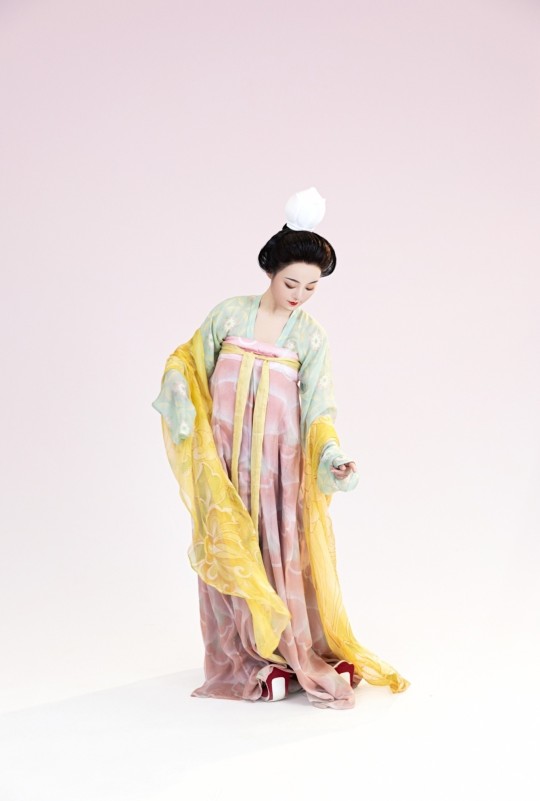






【Historical Reference Artifacts】:
China Tang Dynasty Lotus Crown Female Figurines,Collection of Xi'an Museum

China Tang Dynasty Murals from Prince of Ning Li Xian(李憲)Tomb Mural (742)

[Hanfu · 漢服]Chinese Tang Dynasty(618–907AD) Traditional Clothing Hanfu & Hairstyle Reference to Tang Dynasty Figurines
【History Note】
Wearing a lotus crown is a symbol of Taoism.Until now, Taoists still wear lotus crowns when performing Rituals and only high-level Taoist priests can wear lotus crowns.


Generally, the Taoist priests we see are all male, so many people will misunderstand that Taoist priests can only be male, but this is a wrong statement.
As early as the Jin Dynasty(266–420), the first female Taoist priest appeared: 【Wei Huacun 魏华存】。
Wei was born in 252 in Jining, Shandong in the former county of Rencheng (任城). Her father, Wei Shu (魏舒), was a government official. From an early age she displayed a propensity for studying the works of Laozi and Zhuangzi, and practising Daoist methods of cultivation.
At the age of 24, she was married to Liu Wen (劉文) against her will by her parents and had two sons. After they grew up, she resumed her Daoist practices. At some point she became a libationer in the priesthood of the Celestial Masters sect of Daoism.
Except Wei Huacun, one of the four beauties in China, Tang Dynasty beauty: [Yang Guifei杨贵妃/Yang Yuhuan杨玉环] also used to be a Taoist priest for a while.Her Taoist nun name is Taizhen (太真).
Therefore, it is speculated that she was also wearing a lotus crown when she was a Taoist priest.

In the middle and late Tang Dynasty, lotus crowns were not only worn by female Taoist priests, but ordinary women also liked to wear them. Until the Song Dynasty, the crown worn by women were not limited to the shape of the lotus, and even the material changed, such as: ivory, jade,and so on.
—————————–
🧚🏻Recreation Work: @我是411
🌸Lotus Crown:@时春居荷包
👗Hanfu:@墨名堂的箱掌柜
🔗Weibo:https://weibo.com/2040114485/N7EPOiEHN
—————————–
#chinese hanfu#Tang Dynasty(618–907AD)#hanfu#chinese traditional clothing#hanfu accessories#hanfu_challenge#chinese#chinese history#Taoism#female Taoist priests#lotus crown#china#historical fashion#historical hairstyle#chinese fashion#我是411#时春居荷包#墨名堂的箱掌柜
160 notes
·
View notes
Text
assuming the timeline of tcgf takes place in the zhou dynasty and beyond, xie lian would’ve been educated in the six arts (bc the six arts was established in the zhou dynasty.)
the six arts include (also addressed in mdzs, iirc): rites, music, archery, calligraphy, chariotry and mathematics.
we already known xie lian excels in calligraphy, and given feng xin's dexterity with his bow, it probably isn't too hard of a stretch to say that xie lian also received training in archery even if he heavily favours the sword. i believe rites refer to taoist rituals, because the six arts stemmed from confucianism. (confucianism ≠ taoism, but both follow the tao (道).) anyway, xie lian is a taoist priest/ cultivation is a concept stemmed from taoism, so he'd naturally be competent in the rites of taoism. we'll assume he's decently skilled in chariotry and mathematics.
so that just leaves music.
here's the thing: the guqin was almost exclusively played scholars, generals, nobility, etc, by men of rank, prestige and privilege.
xie lian is royalty so there's a high chance he could play the guqin, and who else in the mxtx universe is also incredibly adept at playing it? lan wangji.
xie lian x lan wangji guqin duets with hua cheng and wei wuxian as their audience. (or consider, wei wuxian joins in with chenqing and hua cheng has an internal breakdown in an attempt to read the scores they're using.)
#OR! singer hua cheng.#he would def be a baritone. for sure.#but envisioning an arts-centric hua cheng being presented with a score and realising its as legible as his handwriting to him#is also very amusing#tcgf#mdzs#hua cheng#xie lian#mxtx#mxtx tgcf#mxtx mdzs#hualian#wangxian
140 notes
·
View notes
Text

Chinese 8 Characters
Hello hello it's time for another BL-related cultural tidbit, this time from Stay By My Side Ep 9! I've been told this was simply translated as "8 Characters" so I thought I'd add a little info about this. And whilst we're at it, let's also talk a little about what we've seen of Bu Xia's family's Taoist temple.
I'm going to preface ALL of this by saying that I don't for a second expect the show to portray much of these cultural elements accurately (I mean much of the portrayal thus far has been pretty tongue-in-cheek anyway). Taoism as it is practiced as a religion in Taiwan is really more of a mix of philosophical Taoism and Chinese Folk Religion, and these concepts and superstitions are a very real part of everyday life, so the majority of Taiwan's (and some Chinese) audiences will be familiar with the very basic ideas about ghosts and Taoist temples and rituals. The elements that you do see in this show are pretty much just a caricature of "actual" practice, and are common misrepresentations in media anyway so it's really fine that the show is just using it as a plot device.
The Chinese 8 Characters, or 八字 (ba zi) may alternatively be translated as 8 character horoscope, or 4 pillars of destiny, or zodiac, or destiny, or fortune. Basically your time and date of birth corresponds to 8 different chinese characters, and using these 8 characters, one can calculate and determine things about your fortune, your health, your likely path in life (in the sense of ups and downs), your compatibility with another person, and even the small things like your lucky colour, number, day of the current month/year etc. It used to be the way to arrange marriages, and in fact a marriage could be called off purely on the fact that the couple's 8 characters did not match or were inauspicious. (A common way to say you've got beef with someone is to say "our 8 characters don't match" - basically implying you guys were destined to be enemies.) It's often the plot point of many period dramas too - a child is born with an unlucky set of characters, or rather characters that are in direct conflict with perhaps the patriach of the family and is thus either killed/abused/sent away. Although nowadays most people don't place much emphasis on Chinese Astrology anymore, it is still used often enough for eg to pick an auspicious day for weddings etc.
Tl;dr it's like tarot card reading + your zodiac + your horoscope all rolled into one, on steroids.
You can do things to improve your luck, or to curse someone else, based on your/their 8 characters. Similarly, you can tie the 8 characters - aka their destiny, for all intents and purposes - together, which is what Sis is talking about here with JC and BX. The stipulations that "[JC] must be pure of heart" and "BX has to write the characters himself" etc are probably just added in for effect (because Taoist rituals don't really work like that 🤣). Specifically, because it is the fate of BX's family and clan to be able to see and hear ghosts, they are going to "control" or "suppress" that part of BX's fate by using JC's 8 characters to "control" BX's. That said, people usually use elemental objects to "augment/alter" the luck/fate foretold by one's 8 Characters - not actual humans 🤣 - but yes this show is not about accuracy and it sounds just about legit enough for the plot point of a show 🤣🤣
Btw in case you were interested, the "secret family manual" from Grandpa that Sis is holding up is the 道家神符灵咒秘传 (Secret Manual of Taoist Talismans and Spells) - which is something apparently written during the Qing Dynasty that you can buy off shady Chinese e-shopping sites🤣. Here're some pictures of the supposed contents!
BX's Family Temple

As mentioned, it's a Taoist temple - even without the manual, we would know this because BX's wooden sword is a Taoist - plus exorcisms and the like are usually more associated with Taoist practice
BX's wooden sword is actually a Peach Wood Sword - these, or Coin-Swords are commonly used in Taoist Rituals, and are often thought to be able to offer protection. However, it's purpose in rituals are mostly ceremonial - they represent the actual swords that were used way back when (after all it's no longer legal to carry swords and well, they're heavy). They are many folk legends surrounding Peaches/Peach wood, so those, combined with the use of sword arts in Taoism, has led to the common belief that Peach Wood sword can ward off evil spirits, bring fortune and wealth, offer protection etc. Also - BX swinging the sword around in his room, whilst looking very cool, is more chinese traditional dance than it is proper ritual use (BX's actor Wei Zhe is afterall, trained in Chinese dance)
It is unusual (but certainly not unheard of), as the show mentions, for a girl to take over the temple as Bu Xia's sister does (and even more unthinkable that someone taking over ritual rites would make a mistake like burning a talisman by accident and thinking it'd be ok hahaha) but this is resolved very simply by the show as "well Bu Xia is too scared to take over"
#stay by my side#免疫屏蔽#chinese cultural tidbits#this show is adorable#i love them so much#i'm not ready to let them go
42 notes
·
View notes